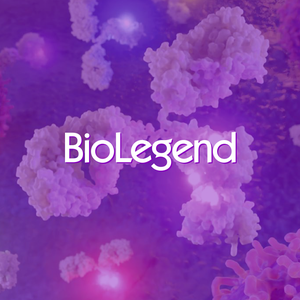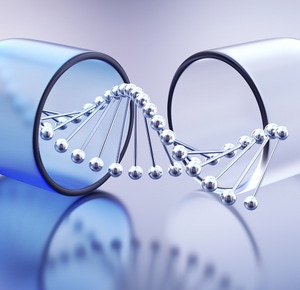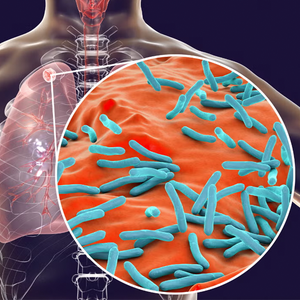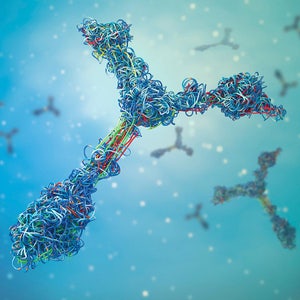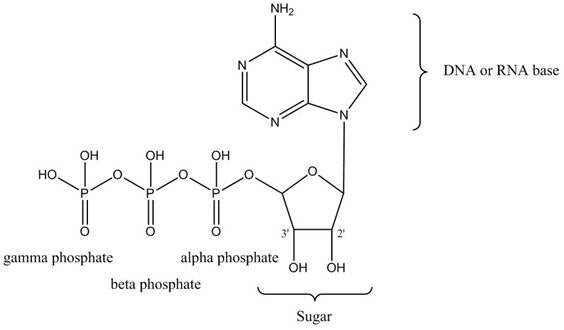
Overview
Information on this page will help you select the best radiochemical formulation for your needs. For additional help, please contact technical support.
Radionucleotides
The radionucleotides in the tables below are labeled on either the alpha phosphate group, or the gamma phosphate group. This designation does not refer to the type of energy that is emitted. 32P and 35S are beta-emitters (they give off beta energy in the form of beta particles). The "alpha" and "gamma" designation refers to the phosphate group of the nucleoside triphosphate that is labeled with the radioisotope. If you are performing an enzymatic assay (phosphorylation with a kinase, end labeling an oligonucleotide with terminal transferase, etc.), it is important to consider how your enzyme is using the nucleotide as a substrate. Your goal is probably to have the enzyme transfer a radiolabeled group from the radionucleotide to a DNA chain, an RNA chain, or a protein. You will need to understand how your enzyme works. Is it incorporating the nucleoside monophosphate (base, sugar, and alpha phosphate group) as part of a DNA or RNA chain? Is it transferring the terminal (gamma) phosphate group from the nucleotide to another substrate? Do you need to use a nucleotide that is deoxy at the 2' position of the sugar (a deoxyribonucleotide, dNTP)? Do you need a "chain terminator" that is deoxy at the 3' position?

Structure of ATP. The entire molecule comprises a nucleotide (also called a nucleoside triphosphate). The alpha, beta, and gamma phosphate groups are indicated. This is not a deoxyribonucleotide, because there is a hydroxyl group at the 2' position of the ribose sugar. This would also not be a chain terminator, as there is a potentially reactive hydroxyl group at the 3' position.
Most NEN™ radionucleotides are available as "EasyTides™", ready-to-use nucleotides in a buffer that allows for ambient shipment and storage at 2 -8°C. This formulation also includes an inert dye for ease of use. NEN radionucleotides are also available "frozen", which is shipped frozen and then stored at -20°C. Note that the higher salt concentration of the EasyTides formulation may interfere with some thermophilic DNA polymerases. See the tables below for detailed ordering information.
Deoxyribonucleotides (DNA nucleotides) for labeling
Use the table below to help select the optimal 32P, 33P or 35S deoxyribonucleotide for your labeling application. View more information on DNA and RNA labeling assays.
| Application | Compound | Specific Activity (Ci/mmol) | Rad. conc. (mCi/mL) | Molar conc. (μM) | EasyTides Version Containing Dye in Buffer (Shipped ambient, store at 2-8°C) | Frozen Version (Shipped on dry ice, store at -20°C) |
|---|---|---|---|---|---|---|
| DNA labeling (Random primer or nick translation) or DNA sequencing (Klenow, T7 DNA polymerase, terminal transferase...) |
dGTP,[alpha-32P] | 3000 | 10 | 3.3 | BLU514H | |
| 6000 | 20 | 3.3 | BLU514Z | BLU014Z | ||
| dTTP,[alpha-32P] | 800 | 10 | 12.5 | BLU505A | BLU005A | |
| 3000 | 10 | 3.3 | BLU505H | BLU005H |
Guidelines for choosing a deoxyribonucleotide from the above table:
- Application
- dNTPs (deoxynucleoside triphosphates) that are labeled on the alpha phosphate group are typically used in reactions involving enzymes that will incorporate the deoxynucleoside monophosphate (base, sugar, and alpha phosphate) into a chain of DNA.
- 3’ end labeling of DNA typically utilizes a chain terminator, such as a dATP that is deoxy at the 3’ position, to prevent further elongation once the radionucleotide has been incorporated. (This controls the degree of labeling). However, “tailing reactions” can also be performed to insert multiple nucleotides at the 3’ end of a DNA molecule using a radionucleotide that is not a chain terminator.
- Compound
- Radionucleotides are labeled with either a 32P or 35S radioisotope. 32P is a high energy beta emitter and will produce the highest signal, while 35S is considered low energy beta emitters, and is sometimes used instead of 32P to improve resolution, especially in sequencing reaction and in situ.
- Radiolabeled dATP, dCTP, dGTP, and dTTP are available. If your reaction is template-dependent, you may need to refer to the sequence of your template to choose the best radionucleotide for your assay. Some enzymatic assays are template-independent (such as end labeling with terminal transferase), and it will not matter whether the radionucleotide is a dATP, a dCTP, etc.
- 3’ dATP is a chain terminator, because it is deoxy- (missing an oxygen) at the 3’ position. It is often used in lieu of ddATP.
- Specific activity
- Specific activity indicates how much radioactivity there is per molecule. The units for specific activity in the table above are Curies per millimole of nucleotide. The theoretical maximum specific activity for 32P is ~9120 Ci/mmol, while the theoretical maximum specific activity for 35S is ~1488 Ci/mmol. Because the nucleotides in this table have only one possible labeling position, the closer the specific activity is to the theoretical maximum specific activity for the radioisotope, the greater the proportion of nucleotide molecules that are labeled with the radioisotope in the stock vial. Remember to factor in decay.
- If you are trying to generate “hot” probes, you will want to choose a radionucleotide with a high specific activity.
- Specific activity can always be decreased by adding more of the same “cold” (unlabeled) nucleotide. This will increase the molar concentration of the nucleotide.
- Radioactive concentration
- Radioactive concentration indicates the amount of radioactivity per volume. If your protocol tells you to add a certain amount of Curies to a reaction, you will need to use the radioactive concentration to determine how much to pipette. Remember to factor in decay.
- Molar concentration refers to the molar concentration of both the labeled and unlabeled nucleotide (combined) in the stock vial.
-
Catalog numbers
You have two choices for each radionucleotide. These differ by:
- Container: BLU products are packaged in a lead-free container (“pig”).
- Formulation: EasyTides products are provided in a proprietary buffer that contains a dye to aid in pipetting and can be stored at 4°C (avoiding freeze-thaw cycles). The EasyTides proprietary buffer does contain a somewhat higher concentration of salt, so you may want to choose a non-EasyTides (frozen) formulation if your enzyme is sensitive to salt (thermophilic polymerases for PCR such as Taq). Frozen products do not contain a dye in the buffer, and should be aliquoted (to avoid freeze-thaw cycles) and stored at -20°C.
Ribonucleotides (RNA nucleotides) for labeling
Use this table to help you select the optimal 32P or 35S ribonucleotide for your labeling application. View more information on DNA and RNA labeling assays.
| Application | Compound | Specific Activity (Ci/mmol) | Rad. conc. (mCi/mL) | Molar conc. (µM) | EasyTides Version Containing Dye in Buffer (Shipped ambient, store at 2-8°C) | Frozen Version (Shipped on dry ice, store at -20°C) |
|---|---|---|---|---|---|---|
| RNA labeling (SP6, T3, T7 RNA polymerase) | ATP, [alpha-32P] | 800 | 10 | 12.5 | BLU003X | |
| 3000 | 10 | 3.3 | BLU503H | BLU003H | ||
| UTP, [alpha-32P] | 800 | 10 | 12.5 | BLU507X | BLU007X | |
| 800 | 20 | 25 | BLU507T | |||
| 800 | 40 | 50 | BLU507C | BLU007C | ||
| 3000 | 10 | 3.3 | BLU507H | BLU007H | ||
| 6000 | 40 | 6.7 | BLU507Z | BLU007Z | ||
| ATPalphaS, [35S] | 1250 | 12.5 | 10 | NEG034H | ||
| UTPalphaS, [35S] | 800 | 40 | 50 | NEG039C | ||
| 1250 | 12.5 | 10 | NEG739H | NEG039H | ||
| 5' end labeling of DNA or RNA (T4 PNK) | ATP, [gamma-32P] | 10 | 2 | 200 | BLU002 | |
| 3000 | 5 | 1.7 | BLU502H | BLU002H | ||
| 3000 | 10 | 3.3 | BLU502A | BLU002A | ||
| 6000 | 10 | 1.7 | BLU502Z | BLU002Z | ||
| 6000 | 150 | 25 | NEG735C |
Guidelines for choosing a ribonucleotide from the above table:
- Application
- rNTPs (ribonucleoside triphosphates) that are labeled on the alpha phosphate group are typically used in reactions involving enzymes that will incorporate the ribonucleoside monophosphate (base, sugar, and alpha phosphate) into a chain of RNA.
- Compound
- Radionucleotides are labeled with either a 32P or 35S radioisotope. 32P is a high energy beta emitter and will produce the highest signal, while 35S is considered low energy beta emitters, and is sometimes used instead of 32P to improve resolution.
- Radiolabled ATP, CTP, GTP, and UTP are available. If your reaction is template-dependent, you may need to refer to the sequence of your template to choose the best radionucleotide for your assay. Some enzymatic assays are template-independent, and it will not matter whether the radionucleotide is an ATP, a CTP, etc.
- Specific activity
- Specific activity indicates how much radioactivity there is per molecule. The units for specific activity in the table above are Curies per millimole of nucleotide. The theoretical maximum specific activity for 32P is ~9120 Ci/mmol, while the theoretical maximum specific activity for 35S is ~1488 Ci/mmol. Because the nucleotides in this table have only one possible labeling position, the closer the specific activity is to the theoretical maximum specific activity for the radioisotope, the greater the proportion of nucleotide molecules that are labeled with the radioisotope in the stock vial. Remember to factor in decay.
- If you are trying to generate “hot” probes, you will want to choose a radionucleotide with a high specific activity.
- Specific activity can always be decreased by adding more of the same “cold” (unlabeled) nucleotide. This will increase the molar concentration of the nucleotide.
- Radioactive concentration
- Radioactive concentration indicates the amount of radioactivity per volume. If your protocol tells you to add a certain amount of Curies to a reaction, you will need to use the radioactive concentration to determine how much to pipette. Remember to factor in decay.
- Molar concentration refers to the molar concentration of both the labeled and unlabeled nucleotide (combined) in the stock vial.
-
Catalog numbers
You have two choices for each radionucleotide. These differ by:
- Container: BLU products are packaged in a lead-free container (“pig”).
- Formulation: EasyTides products are provided in a proprietary buffer that contains a dye to aid in pipetting and can be stored at 4°C (avoiding freeze-thaw cycles). The EasyTides proprietary buffer does contain a somewhat higher concentration of salt, so you may want to choose a non-EasyTides (frozen) formulation if your enzyme is very sensitive to salt. Frozen products do not contain a dye in the buffer, and should be aliquotted (to avoid freeze-thaw cycles) and stored at -20°C.
Nucleotides for kinase and other protein-based assays
Use this table to help you select the optimal 32P or 35S nucleotide for your kinase or protein-based assay. View more information on phosphorylation assays. View more information on GTP binding assays.
| Application | Compound | Specific Activity (Ci/mmol) | Rad. conc. (mCi/mL) | Molar conc. (μM) | EasyTides Version Containing Dye in Buffer (Shipped ambient, store at 2-8°C) | Frozen Version (Shipped on dry ice, store at -20°C) |
|---|---|---|---|---|---|---|
| Protein phosphorylation, 5' end labeling of DNA or RNA (T4 PNK, protein kinase) | ATP, [gamma-32P] | 10 | 2 | 200 | BLU002 | |
| 3000 | 5 | 1.7 | BLU502H | BLU002H | ||
| 3000 | 10 | 3.3 | BLU502A | BLU002A | ||
| 6000 | 10 | 1.7 | BLU502Z | BLU002Z | ||
| 6000 | 150 | 25 | NEG035C | |||
| Adenyl and guanyl cyclase assays | ATP, [alpha-32P] | 800 | 10 | 12.5 | BLU003X | |
| 3000 | 10 | 3.3 | BLU503H | BLU003H | ||
| GTP, [alpha-32P] | 800 | 10 | 12.5 | BLU006X | ||
| GTP binding/G Protein/P2Y receptor studies | GTPgammaS, [35S] non- hydrolyzable |
1250 | 12.5 | 10 | NEG030H | |
| 1250 | 1 | 0.8 | NEG030X |
Guidelines for choosing a ribonucleotide from the above table:
- Application
- Protein thiophosphorylation is a protein phosphorylation technique (for protein kinases) that uses a 35S-labeled ATP. The reaction is the same as for protein phosphorylation assays using ATPγ 32P.
- Cycle sequencing reactions measure the dissociation of the gamma phosphate group of GTP during hydrolysis of GTP to GDP.
- Adenyl and guanyl cyclase assays measure the conversion of radioactive ATP or GTP to radioactive cAMP or cGMP, respectively.
- ADP ribosylation measures ADP-ribosylated proteins by incorporation of radiolabeled NAD
- GTP binding assays are functional assays for GPCRs, and measure exchange of GDP for radiolabeled, non-hydrolyzable GTP analog upon activation.
- Compound
- Radionucleotides are labeled with either a 32P or 35S radioisotope. 32P is a high energy beta emitter and will produce the highest signal, while 35S is considered low energy beta emitters, and is sometimes used instead of 32P to improve resolution in autoradiography.
- Specific activity
- Specific activity indicates how much radioactivity there is per molecule. The units for specific activity in the table above are Curies per millimole of nucleotide. The theoretical maximum specific activity for 32P is ~9120 Ci/mmol, while the theoretical maximum specific activity for 35S is ~1488 Ci/mmol. Because the nucleotides in this table have only one possible labeling position, the closer the specific activity is to the theoretical maximum specific activity for the radioisotope, the greater the proportion of nucleotide molecules that are labeled with the radioisotope in the stock vial. Remember to factor in decay.
- Radiochemical concentration
- Radiochemical concentration indicates the amount of radioactivity per volume. If your protocol tells you to add a certain amount of Curies to a reaction, you will need to use the radioactive concentration to determine how much to pipette. Remember to factor in decay.
- Molar concentration refers to the molar concentration of both the labeled and unlabeled nucleotide (combined) in the stock vial.
-
Catalog numbers
You have two choices for each radionucleotide. These differ by:
- Container: BLU products are packaged in a lead-free container (“pig”).
- Formulation: EasyTides products are provided in a proprietary buffer that contains a dye to aid in pipetting, and can be stored at 4°C (avoiding freeze-thaw cycles). The EasyTides proprietary buffer does contain a somewhat higher concentration of salt, so you may want to choose a non-EasyTides (frozen) formulation if your enzyme is very sensitive to salt. Frozen products do not contain a dye in the buffer, and should be aliquoted (to avoid freeze-thaw cycles) and stored at -20°C.
Methionine
Refer to information directly below the table for more guidance. View more information on cell labeling with 35S methionine.
| Product | When to Use This Formulation | Rad. conc./Specific Activity | Buffer | Storage and Stability | Catalog Number |
|---|---|---|---|---|---|
| EXPRESS [35S]-protein labeling mix |
|
11 mCi/mL 1175 Ci/mmol |
|
Shipped on dry ice. Store at -80°C. Use within 1 month. | NEG072 |
|
11 mCi/mL 1175 Ci/mmol |
|
Shipped ambient. Store at 4°C. Use within 1 month of receipt | NEG772 | |
| Methionine, L-[35S] |
|
43.3 mCi/mL 1175 Ci/mmol |
|
Shipped in dry ice, Store at -20°C or lower. Use within 1 month of receipt | NEG009C |
|
10.2 mCi/mL 1175 Ci/mmol |
|
Shipped in dry ice, Store at -20°C or lower. Use within 1 month of receipt | NEG009A | |
|
10.2 mCi/mL 1175 Ci/mmol |
|
Shipped ambient, Store at 4°C or lower. Use within 1 month of receipt | NEG709A | |
|
31.5 mCi/mL 1175 Ci/mmol |
|
Shipped in dry ice, Store at -20°C or lower. Use within 1 month of receipt | NEG009L | |
|
11 mCi/mL 1175 Ci/mmol |
|
Shipped in dry ice, Store at -20°C or lower. Use within 1 month of receipt | NEG009H | |
|
11 mCi/mL 1175 Ci/mmol |
|
Shipped in dry ice, Store at -20°C or lower. Use within 1 month of receipt | NEG009T |
*IVT stands for In Vitro Translation
Guide for using above table:
- Product
- EXPRE35S35S labeling mix contains both 35S-methionine and 35S-cysteine. The material is prepared from a crude extract of E. coli
- In EXPRE35S35S labeling mix, the relative concentration of methionine and cysteine is 73% to 22%.
- When to use...
- Cell labeling experiments refer to cell-based assays.
- IVT refers to cell-free in vitro translation assays (for example, using a reticulocyte lysate).
- Radioactive concentration/specific activity
- Radioactive concentration is sometimes used to determine what volume of radiochemical to use to make your working solutions, or what volume of radiochemical to add to your assay. If your protocol dictates that you add a certain amount of Curies to each reaction, you will use the radioactive concentration to determine how much to pipette.
- All products are currently offered at the same specific activity. Specific activity indicates the amount of radioactivity per millimole of methionine. The maximum theoretical specific activity for 35S is ~1488 Curies per millimole of sulfur. Because there is only one possible labeling position on these radiochemicals, a specific activity of 1175 Ci/mmol indicates that a large proportion of the molecules in the vial are labeled on the calibration date.
- Molar concentration (of both hot and cold methionine in the stock vial) can be determined by taking the radioactive concentration and dividing by the specific activity. Make sure your units cancel out correctly. If your protocol is telling you to add a higher molar concentration than what the product is supplied as, you may need to increase the molar concentration by adding cold methionine. This will decrease the specific activity of radiolabeled methionine in the assay.
- Buffer
- Tricine is a stabilizing buffer. Products packed in tricine should have greater stability through multiple manipulations, though we still recommend using 35S-methionine products within one month of receipt.
- EasyTag products are in a proprietary buffer formulation that allows the product to be stored at 4°C
- β-mercaptoethanol is a reducing agent and helps to slow the build-up of volatile 35S by-products in the stock vial over time. However, β-mercaptoethanol can be somewhat toxic to cells. Regardless of which formulation you chose, always take appropriate safety precautions when working with radioactivity – talk to your radiation safety officer for more guidance.
- Storage and stability
- Most products need to be stored at -20°C or lower. EasyTag products can be stored at 4°C.
- We recommend you use 35S-methionine within one month of receipt.
Thymidine
Refer to the information below the table for more guidance. View more information on thymidine uptake assays.
| Primary Application | Compound | Specific Activity | Rad. conc. (mCi/mL) | Packaging Buffer | Storage Temp. | Notes | Catalog Number |
|---|---|---|---|---|---|---|---|
| DNA proliferation | Thymidine, [methyl-3H] | 2 Ci/mmol | 1 | Steri-packaged, aqueous solution | 5°C | Recommend use within one month of receipt | NET027A |
| 6.7 Ci/mmol | 1 | Steri-packaged, aqueous solution | 5°C | Recommend use within one month of receipt | NET027 | ||
| 20 Ci/mmol | 1 | Steri-packaged, aqueous solution | 5°C | Recommend use within one month of receipt | NET027X | ||
| 20 Ci/mmol | 1 | 70% ethanol | -20°C | NET027E | |||
| 40-60 Ci/mmol | 1 | 2% ethanol | 5°C | NET027W | |||
| 70-90 Ci/mmol | 1 | Steri-packaged, aqueous solution | 5°C | Recommend use within one month of receipt | NET027Z | ||
| Total nucleic acid proliferation | Thymidine, [2-14C] | >50 mCi/mmol | 0.1 | Steri-packaged, aqueous solution | 5°C | NEC156 | |
| Thymidine, [6-3H] | >10 Ci/mmol | 1 | Steri-packaged, aqueous solution | 5°C | NET355 | ||
| DNA probe labeling | Deoxythymidine triphosphate, [methyl-3H] | 10-25 Ci/mmol | 1 | 50% ethanol | -20°C | NET221H | |
| 70-90 Ci/mmol | 1 | 50% ethanol | -20°C | NET221X | |||
| 70-90 Ci/mmol | 2.5 | 10 mM Tricine buffer pH 7.6 | -80°C | NET221A |
Guidelines for choosing a thymidine radiochemical from the table above:
- Primary application
- Most cell proliferation assays measure DNA proliferation (incorporation of radiolabeled thymidine into DNA, specifically)
- Total nucleic acid proliferation can also be studied using a thymidine that is radiolabeled, but not on the methyl group.
- DNA probes are created by incorporation of deoxythymidine triphosphate (dTTP)
- Compound
- Either 14C-labeled thymidine or 3H-thymidine can be used in proliferation assays. 14C has higher energy compared to3H. 14C also has higher efficiency compared to 3H in liquid scintillation counting. Your radioactive license may restrict you to one radioisotope or the other. You will want to consult your radiation safety officer when selecting a radioisotope for your assay.
- Specific activity
- Specific activity indicates how much radioactivity there is per molecule. The units for specific activity in the table above are Curies per millimole of thymidine, or milliCuries per millimole of thymidine. The theoretical maximum specific activity for 3H is ~29 Ci/mmol. Because there are multiple possible H labeling positions in these products, the specific activity of some 3H thymidine products will be greater than the theoretical maximum specific activity for 3H. This indicates that on average, each thymidine molecule has more than one tritium. The theoretical maximum specific activity for 14C is ~62 mCi per millimole of 14C. Because there is only one possible carbon labeling position on these products, products with a specific activity that approaches the theoretical maximum specific activity for 14C indicate that nearly every thymidine molecule is labeled with 14C.
- If you need your assay to be very sensitive, choose a product with high specific activity (for the given radioisotope).
- Specific activity can always be decreased by adding more of the same “cold” (unlabeled) thymidine. This will increase the molar concentration of thymidine.
- Radioactive concentration
- Radiochemical concentration indicates the amount of radioactivity per volume. If your protocol tells you to add a certain amount of Curies to a reaction, you will need to use the radioactive concentration to determine how much to pipette.
- Packaging buffer
- Thymidines that are packaged in ethanol tend to have a longer shelf-life, however, ethanol can be toxic to cells. You may need to evaporate off any ethanol prior to using in an assay.
- Products that are “steri-packaged” are prepared with additional precautions to substantially reduce product bioburden and enhance product stability. Revvity makes no warranties, whether expressed or implied, with respect to the sterility or non-pyrogenicity of these or any products.
- Notes
- Some products have explicit recommended time frames during which they can be used. This is because degradation studies have shown the chemical structure of the product degrades over time to the extent that it is no longer recommended for its intended application. The packaging buffer influences the shelf-life of the product. Thymidine packaged in ethanol will have a longer shelf-life than aqueous thymidine.
Iodine for protein labeling
Iodine-125 is typically used for labeling peptides and proteins. For more information on Iodination see Choosing an iodination technique.
| Product | When to Use This Formulation | Rad. conc./Specific Activity | Buffer | Storage and Stability |
|---|---|---|---|---|
| NEZ033 Iodine-125 (carrier-free) | High pH formulation minimizes volatility. Adjust pH as needed with HCl or acetic acid. Packaged in 0.1 mL volume regardless of amount of radioactivity ordered. (Radioactive concentration varies depending on amount ordered.) | Radioactive concentration depends on size ordered, ~17 Ci/mg | 0.1M NaOH, pH 12-14 | Shipped ambient. Store at room temperature. |
| NEZ033A Iodine-125 (carrier-free) | Lower pH is more convenient, requiring less adjustment. | 100 mCi/mL, ~17 Ci/mg | 1X10-5M NaOH, pH 8-11 | Shipped ambient. Store at room temperature. |
| NEZ033H Iodine-125 (carrier-free) | High pH formulation minimizes volatility. Adjust pH as needed with HCl or acetic acid. Recommended for Iodogen labeling. | 350 mCi/mL, ~17 Ci/mg | 0.1M NaOH, pH 12-14 | Shipped ambient. Store at room temperature. |
| NEZ033L Iodine-125 (carrier-free) | Lower pH is more convenient, requiring less adjustment. | 350 mCi/mL, ~17 Ci/mg | 1X10-5M NaOH, pH 8-11 | Shipped ambient. Store at room temperature. |
| NEX120 Bolton-Hunter Reagent125I mono-iodinated | The mono-iodinated form is generally recommended for most Bolton-Hunter iodinations. | 2200 Ci/mmol | Packaged in anhydrous benzene. A charcoal trap is included with each vial. | Shipped ambient. Store at room temperature |
Glucose for glucose uptake assays
Refer to the information below this table for guidance in choosing your glucose or glucose analog for a glucose uptake assay. View more information on glucose uptake assays.
| Chemical | Radioisotope | Labeling | Solvent | Specific Activity | Rad. conc. | Storage | Catalog Number |
|---|---|---|---|---|---|---|---|
| 2-deoxy-D-glucose | 3H | N (1,2 position) | 90% ethanol | 5-10 Ci/mmol | 1 mCi/mL | -20°C | NET328 |
| N (1,2 position) | steri-packaged aqueous solution | 5-10 Ci/mmol | 1 mCi/mL | 4°C | NET328A | ||
| N (1,2 position) | 90% ethanol | 25-50 Ci/mmol | 1 mCi/mL | -20°C | NET549 | ||
| N (1,2 position) | steri-packaged aqueous solution | 25-50 Ci/mmol | 1 mCi/mL | 4°C | NET549A | ||
| 14C | (position 1) | 90% ethanol | 45-60 mCi/mmol | 0.1 mCi/mL | -20°C | NEC495 | |
| (position 1) | steri-packaged aqueous solution | 45-60 mCi/mmol | 0.1 mCi/mL | 4°C | NEC495A | ||
| U | steri-packaged aqueous solution | 250-350 mCi/mmol | 0.1 mCi/mL | 4°C | NEC720A | ||
| 3-O-methyl-D-glucose | 14C | (methyl group) | 90% ethanol | 30-60 mCi/mmol | 0.1 mCi/mL | -20°C | NEC377 |
| D-Glucose | 3H | N (2 position) | 90% ethanol | 20-30 Ci/mmol | 1 mCi/mL | -20°C | NET238C |
| (3 position) | 90% ethanol | 10 -20 Ci/mmol | 1 mCi/mL | -20°C | NET331C | ||
| (3 position) | steri-packaged aqueous solution | 10-20 Ci/mmol | 1 mCi/mL | 4°C | NET331A | ||
| N (5 position) | 90% ethanol | 10-20 Ci/mmol | 1 mCi/mL | -20°C | NET531 | ||
| N (6 position) | 90% ethanol | 25-50 Ci/mmol | 1 mCi/mL | -20°C | NET100C | ||
| 14C | (position 1) | 90% ethanol | 45-60 mCi/mmol | 0.1 mCi/mL | 4°C | NEC043X | |
| (position 6) | 3% ethanol | 50-62 mCi/mmol | 0.2 mCi/mL | -20°C | NEC045X | ||
| U | 90% ethanol | 1-5 mCi/mmol | 0.1 mCi/mL | 4°C | NEC042A | ||
| U | 90% ethanol | 250-360 mCi/mmol | 1 mCi/mL | 4°C | NEC042B | ||
| U | 90% ethanol | 250-360 mCi/mmol | 0.1 mCi/mL | 4°C | NEC042X | ||
| U | 3% ethanol | 250-360 mCi/mmol | 0.2 mCi/mL | -20°C | NEC042V |
How to select a radiochemical from the above table:
- Chemical
- Deoxy-D-glucose (DOG) is a glucose analog that is readily transported into most cells, is phosphorylated and trapped by the cells (unidirectional transport), and cannot be further metabolized. It is the most-common chemical used in glucose uptake assays.
- 3-O-methyl-D-glucose (OMG) is another glucose analog that is readily transported into most cells, but does not become phosphorylated and therefore will equilibrate across the cell membrane. Equilibrium is usually reached rapidly, so the assay may only be linear for a short period of time; you may need to take your measurements fairly quickly. This analog also cannot be further metabolized by cells.
- D-Glucose (non-analog) can be incorporated into lipids, which provides a measurement of glucose transport. It is a metabolized tracer.
- Radioisotope: Either 14C-labeled glucose and glucose analogs, or 3H-labeled glucose and glucose analogs, can be used in glucose uptake assays. 14C has higher energy compared to 3H. 14C also has higher efficiency compared to 3H in liquid scintillation counting. Your radioactive license may restrict you to one radioisotope or the other. You will want to consult your radiation safety officer when selecting a radioisotope for your assay.
- Packaging
- Glucose that is packaged in ethanol will be more-resistant to contamination by bacteria or other microbes. Preventing contamination is one way to ensure the longest shelf-life for a chemical (particularly in the case of glucose, because it is an excellent food-source for microbes).
- For cell labeling or in vivo experiments, you may need to evaporate off any ethanol in the stock material prior to use, as ethanol can be toxic to cells.
- Products that are “steri-packaged” are prepared with additional precautions to substantially reduce product bioburden and enhance product stability. Revvity makes no warranties, whether expressed or implied, with respect to the sterility or non-pyrogenicity of these or any products.
- Labeling positions: for uptake assays, the actual positioning of label is of less importance than it would be if you were performing an enzymatic assay, as uptake of the intact glucose or glucose analog is being traced
- U (uniformly labeled): designation for compounds labeled in all positions in a uniform or nearly uniform pattern
- N (nominally labeled): designation when the method of preparation requires some (usually a significant amount) of the label to be at a specific site or sites, but no further information is available on the extent (if any at other positions)
- G (generally labeled): designation for compounds in which there is a random distribution of radioactivity at various positions
- Specifically labeled: designation used when all labeled positions are identified and the radioactivity at these positions is greater than 95% of the total incorporated into the compound
- Specific activity: the higher the specific activity, the greater the amount of radioactivity there is per glucose molecule. Specific activity is given in units of Curies per millimole of glucose or glucose analog, or milliCuries per millimole of glucose or glucose analog. The theoretical maximum specific activity of tritium is ~29 Ci/mmol (Curies per millimole of tritium). 3H products with a specific activity over this value indicate that on average, each glucose or glucose analog molecule contains more than one tritium. The theoretical maximum specific activity of 14C is ~62 mCi/mmol (milliCuries per millimole of carbon). 14C products with a specific activity over this value indicate that on average, each glucose or glucose analog molecule contains more than one labeled carbon. Specific activity can be decreased by adding cold glucose or glucose analog.
Phosphate for cell labeling
Refer to the information below this table for guidance in choosing a product for your cell labeling assay.
| Product | Isotope | Diluent | Specific Activity | Radioactive Concentration | Catalog Number |
|---|---|---|---|---|---|
| Orthophosphoric acid (orthophosphate), carrier-free | 32P | Water | 8500-9120 Ci/mmol | Depends on size ordered - packaged in 1 mL water, no matter size | NEX053 |
| >500 mCi/mL | NEX053C | ||||
| 10 mCi/mL | NEX053H | ||||
| Monopotassium phosphate | 32P | Water | 900-1100 mCi/mmol | Varies depending on amount of radioactivity ordered - packaged in 1 mL water, no matter size | NEX060 |
Guidance for using above table:
- Most protocols use orthophosphate rather than a phosphate salt for labeling
- If your protocol calls for carrier-free 32P phosphate, use NEX053/NEX053C/NEX053H/NEX053S.
- Higher specific activity indicates that there is more radioactivity per millimole or milligram of phosphorus. Units are given either as Curies per millimole of phosphorus, or Curies per milligram of phosphorus. As you approach the theoretical maximum specific activity for a radionuclide (~9120 Ci/mmol for 32P), a greater proportion of phosphorus in the stock vial is labeled. Products at maximum theoretical specific activity for a given isotope are termed "carrier-free". Specific activity can be lowered by adding cold phosphate.
- For the products above, use the molecular weight of phosphorus itself (rather than the phosphate salt) to convert from Ci/mmol to Ci/mg, and vice versa.
Radioligands for ligand binding assays
View more information on radioligand binding assays. When selecting a radioligand, there are a few factors to keep in mind:
When selecting a radioligand, there are a few factors to keep in mind:
High specific activity: Radioligands with a high specific activity are well-suited for ligand binding assays. Specific activities indicate how much radioactivity there is per molecule of ligand, and is usually given in units of Curies per millimole of ligand. Several of our 125I-labeled ligands are offered at maximum specific activity (2200 Ci/mmol if one 125I labeling site is available, 4400 Ci/mmol if two 125I labeling sites are available, etc.). This indicates that virtually every molecule of ligand provided in the stock vial is radiolabeled. For tritiated ligands (3H ligands), you should ideally pick a ligand that has a specific activity above 20 Ci/mmol. The maximum theoretical specific activity per tritium is 29 Ci/mmol (Curies per millimole of tritium). Specific activities above this value indicate that on average, each molecule of ligand has at least one tritium.
Low non-specific binding: Hydrophobic ligands will generally show higher non-specific binding. This can sometimes be compensated by coating filters with BSA to reduce non-specific binding. Including BSA, salts or detergents in the wash or binding buffer can also help reduce non-specific binding. If the stock radiochemical is packaged in a silanized vial (refer to the tech data sheet), this may indicate the ligand is somewhat hydrophobic.
High purity: Ideally, the ligand should have a radiochemical purity above 90%. Radiochemical purity decreases over time, and the actual rate of this degradation accelerates over time. Radiochemical purity and degradation rates for our various radiochemicals can be found on the lot-specific technical data sheets.
High selectivity: The more selective the ligand is for your receptor, the better your data will be. High selectivity indicates the ligand will mostly be recognized by only one receptor-of-interest, over other receptors that may be present in a cell membrane. Also, using membranes that over-express the receptor of interest may help reduce any potential contribution from receptors endogenously expressed in the membrane.
Stability: If you will need to use your radioligand over an extended period of time, stability may be a factor for you. 125I-labeled ligands should generally be used within one to two months of the manufacture date. Tritiated ligands should usually be used within 3-6 months of manufacture date; however, there are exceptions to this. Degradation rates and manufacturing dates can be found on our lot-specific technical data sheets. You can also contact technical support to discuss the recommended use time for each Revvity radiochemical - our contact information is on the upper right-hand corner of this page.
Energy: 3H releases beta energy, which can be measured on a scintillation counter after the addition of scintillant (in the form of a scintillation cocktail, Meltilex™ solid scintillant, an SPA bead, etc.). The beta energy interacts with the scintillant to produce photons, which are measured by the detector. 125I releases both beta-like energy and gamma energy. If you only have access to a gamma counter, you should use a radioligand labeled with 125I. An additional factor is assay format. 125I gives off more beta-like energy than 3H. For SPA assays, either 3H or 125I-labeled ligands can be used effectively.
For research use only. Not for use in diagnostic procedures. The information provided above is solely for informational and research purposes only. Revvity assumes no liability or responsibility for any injuries, losses, or damages resulting from the use or misuse of the provided information, and Revvity assumes no liability for any outcomes resulting from the use or misuse of any recommendations. The information is provided on an "as is" basis without warranties of any kind. Users are responsible for determining the suitability of any recommendations for the user’s particular research. Any recommendations provided by Revvity should not be considered a substitute for a user’s own professional judgment.


